 |
Hurricane
L1547 - Speke,
10th October 1940 |
 |
Hurricane
L1547 - Speke,
10th October 1940 |
Last updated 25.03.2008
Note: This incident is of particular interest as in addition to being the squadron's first fatality, it was also the loss of the first production Hurricane.
|
| Type | Serial |
Unit | Base | Duty | Crew | Passengers |
| Hawker Hurricane | L1547 |
No 312 (Czech) Squadron |
Speke | Training Flight | 1 |
- |
On the 10th October 1940, Sergeant Otto Hanzlicek 787697, of No 312 (Czech) squadron, took off from the RAF station at Speke airport, Liverpool in Hawker Hurricane I No L1547 along with Pilot Officer Dvorak on practice enemy aircraft attacks in the Liverpool area. At 14.15 hours the engine of his aircraft caught fire and he was forced to abandon his aircraft near Oglett, but the wind blew him out over the River Mersey, and after problems with his parachute due to bailing out too low, he fell down into the River Mersey, some 300 - 400 yards from the edge of the river and was drowned. He was seen to fall into the water on the North side of the river by a farmer near Oglett, but when he arrived at the river bank 10 minutes later there was nothing to be seen. His aircraft came down into the River off the end of runway 08 and had been seen to be emitting smoke over the river just opposite to the airfield by personnel at the station.
His body was found 5 miles to the east from Speke at Widnes on the 1st November 1940. On the 4th November 1940 the inquest into the cause of Hanzlicek's death was held at Widnes, the finding was "Death due to Asphyxia from drowning". On the morning of 5th November 1940 Hanzlicek's funeral was held at the RC Church in Allerton were a short service was held, and he was then buried in Liverpool West Derby Cemetery, Section RC11 grave No 392. The coffin was covered with the Union Jack and the Czech flag, on which rested the "Croix de Guerre" that Hanzlicek had been awarded in France. Sgt Hanzlicek was the first pilot to be killed from No 312 (Czech) squadron, at the age of 29. At the time of the accident he had 930 flying hours to his credit, with 7 of these on Hurricanes.
Mr Alan Davie who lives in Liverpool was a British member of No 312 (Czech) squadron who served at Speke and had vivid memories of the moment the aircraft crashed into the river: "I had just returned from lunch when I heard the sound of engines approaching. I thought it was the Germans as they had flown in a few days earlier and tried to bomb the airport, but our lads had shot them down. When I realised what was happening, I just put my hands together and said a prayer. I saw the Hurricane and pilot falling from the sky . If the wind had been kind to him, he could have landed in Ellesmere Port and survived. He fell into the river and his parachute was falling from the sky behind him. As he went into the water he went under but then came back to the surface. As he did, his parachute came down on top of him. I witnessed some horrific sights during my time in the air force, but that particular day is one I will never forget."
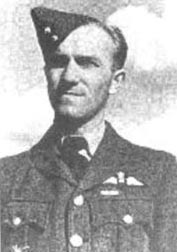 |
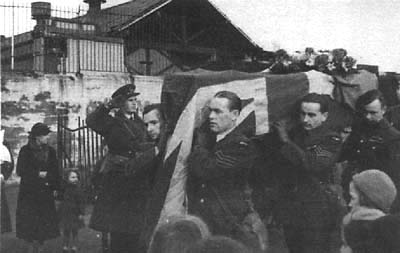 |
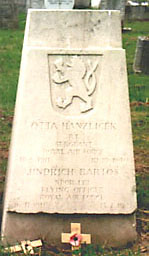 |
| Sgt Hanzlicek in RAF uniform 1940. | Sgt Hanzlicek's funeral. | His Grave in West Derby Cemetery, July 2001. |
The squadron had been on a high as two days previously on the 8th October 1940, pilots of the squadron shot down their first enemy aircraft, a Ju88 that had tried to attack the Rootes factory on the perimeter of the airfield. The Ju88 crashed on the opposite bank of the river at Brombrough on the Wirral and this victory was recorded as probably the fastest kill of the war, talking around eleven minutes from take-off to landing, being watched by Squadron personnel and many of the local residents.
No 312 (Czech) Squadron came into being as the second Czechoslovak fighter unit and was formed on 29th August 1940 at the Czech aircrew depot at RAF Cosford. The home base of the squadron was RAF Duxford, the same airfield where No 310 (Czech) Squadron was based . Two days later the first nine used MkI Hawker Hurricanes were flown into Duxford and on the 4th September 1940 a MkI Miles Master joined them. Czech airmen, flying personnel and ground staff, arrived at RAF Duxford during afternoon of the 5th September 1940. The squadron was based around experienced pilots, who already had combat experience during the Battle of France and many of whom already had more then one victory.
|
| Sgt Hanzlicek at Chartres with other Czech pilots, Hanzlicek is 4th from left. |
On the 6th September 1940, the pilots began theoretical preparation for flying on the Hurricanes and training flights on the Master. This proved a very slow process, due to the fact the unit had just the one trainer aircraft! To speed things up, another Master was loaned from No 310 (Czech) Squadron. After nearly a month the level of training was very high and on the 26th September the squadron moved to its new home, the RAF station at Speke airport, Liverpool. There the unit completed its retraining and in the last days of September obtained further Hurricanes. On the 2nd October 1940, No 312 (Czech) Squadron was declared operational and its task was to protect the Liverpool area from enemy raids. The squadron left Speke for RAF Valley on Anglesey, on the 3rd March 1941. The squadrons motto was, Non multi sed multa - 'Not many but much' and the squadron badge was a Stork volant. The Stork in the badge relates to the French 'Escadrille des Cygelines' with whom the original pilots of No 312 (Czech) squadron had flown prior to coming to the UK.
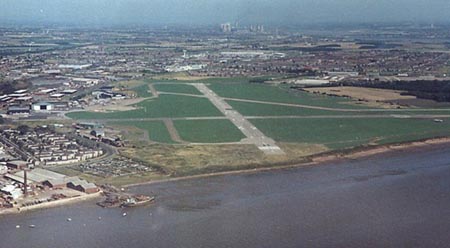 |
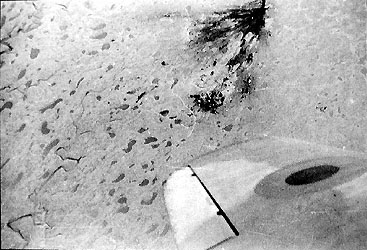 |
| Oblique view of the airfield, circa mid 1970s - crash site of L1547 was just offshore from the end of the main runway 08, | The impact site of L1547 on tidal mud flats, seen from another 312 Squadron aircraft the day after the crash |
Hurricane I No L1547, powered by a Merlin II, was the first production aircraft built under contract No 527112/36 and first flew on the 12th October 1937 at Hawker's, Brooklands factory. It was flown by Phillip Lucas, Flight Lieutenant P.W.S. Bulman's assistant test pilot and subsequently it was used for flying performance and engineering trials at various establishments before entering Squadron service. No 312 squadron had a number of older aircraft on its strength, causing many servicing difficulties.
| L1547 - First flown on 12/10/1937 |
| Taken on charge by Hawkers on 29/03/1938 |
| Taken on charge by A&AEE on 23/06/1938 |
| Taken on charge by Rolls Royce on 28/06/1938 |
| Taken on charge by A&AEE on 21/07/1938 |
| Taken on charge by No 15 MU on 29/05/1940 |
| Taken on charge by No 10 MU on 10/06/1940 |
| Taken on charge by No 312 (Czech) Squadron on 31/08/1940 |
| Fatal accident on 10/10/1940 |
| Struck off charge on 29/10/1940 |
NB: Up until the 1970's aircraft wreckage believed to be from this Hurricane could be seen at low tide, but has now disappeared into the ever-shifting deep mud, and it is believed that the remains are now buried under ballast from a light gantry for the airport. A few pieces of the aircraft were recovered in the 1960s when a couple of spars were showing about 50 yards out and these are now at the War Plane Wreck Museum at Fort Perch Rock, New Brighton. The canopy was apparently found on a local farm and went to a local ATC unit.
Sergeant Otto Hanzlicek 787697, was born on the 18th June 1911, in Usti nad Labem. In the summer of 1939 he escaped from Czechoslovakia to Poland after it had been occupied, from Poland he went to France with a number of other Polish pilots. After retraining on French aircraft at the Fighter school at Chartres, he was posted to Groupe de Chasse II/5 at Toul-Croix-de-Metz in December 1939.
Flying on Curtiss Hawk 75's he shared in the destruction of several German aircraft, beginning on the 23rd April 1940 with a probable Dornier Do17 and the on the 11th May 1940 a Heinkel He111. On the 18th May 1940 in conjunction with a French pilot shot down a Messerschmitt Bf109, but then Hanzlicek himself was attacked by a another Messerschmitt Bf109 flown by Gunther Rall and his aircraft set on fire, he was forced to abandon his aircraft and parachuted to safety.
He was later awarded the Croix de Guerre with Silver Star and bar and also received the Czech War Cross. Hanzlicek came to England via North Africa and Gibraltar. He joined the RAFVR on the 19th September 1940, being posted to No 312 (Czech) Squadron, where he qualified to be a Battle of Britain pilot. He was one the original members of the squadron and would have been sadly missed, as he was an accomplished pilot, credited with 2 victories and one probable.
| Position | Rank | Name | Service No | Age | Status |
| Pilot | Sergeant | Otto Hanzlicek | 787697 | 29 | Killed |
Also buried within the same grave as Hanzlicek is Pilot Officer Jindrich Bartos 83220 of No 312 (Czech) Squadron), who died on the 13th February 1941 whilst on a training flight in Hurricane 1 V6885 (DU-V), his aircraft went into a spin and crashed at Talagre near Prestatyn, Wales at 14:30 hours.
P/O Jindrich Bartos |
Acknowledgements:
Mark Gaskell, Pavel Vancata, Dick Baker, David J Smith, Mark Evans.
References:
Czechoslovak airmen in the RAF 1940-45, Action Stations 3, Commonwealth War Graves Commission, "Flypast", No 312 squadron ORB, The British fighter since 1912, AM Form 78, AM Form 1180.
This page Copyright © Mark Gaskell & Nick Wotherspoon 2001